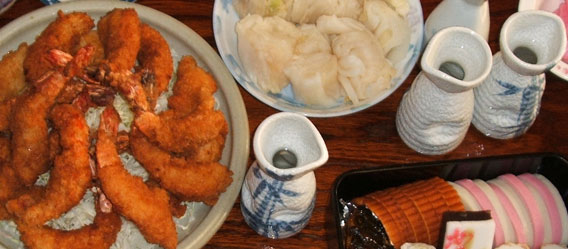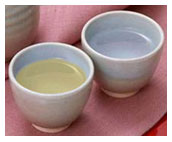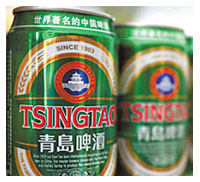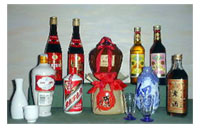|

Anyone who enjoys drinking alcoholic beverage will agree that alcohol permeates more parts of our lives than we may know. It is social, cultural and, at times, alcohol also plays an indispensible part even in religion. It is not only a wonderful way to enhance one’s dining experience, it is also the perfect way to relax and loosen up for an evening of fun with friends.
This month, at Mrs. Lin’s Kitchen, we look at the amazing variety, production processes and history of a wide range of Asian alcohol in our two-part newsletter.Be prepared for a surprising and delightful journey into the varied and exotic flavors of Asian alcohol. This month we begin in China. We will look at the popular Chinese alcohol and the lesser known. Say bottom’s up, or as the Chinese puts it “Gone Bui”, and dive into the rich world of Chinese alcohol.
Chinese
 In general, Chinese alcohol, known as “jiu”, can be divided into two main classes. “Huang jiu”, yellow liquor” and “Bai jiu”, “white liquor”. Huang jiu, or yellow liquor, is produced from the process of fermentation, while Bai jiu, or white liquor, is produced from a process of distillation. But beyond these two main classification, we should also not forget, the well loved and popular alcoholic beverage—Chinese beers. In general, Chinese alcohol, known as “jiu”, can be divided into two main classes. “Huang jiu”, yellow liquor” and “Bai jiu”, “white liquor”. Huang jiu, or yellow liquor, is produced from the process of fermentation, while Bai jiu, or white liquor, is produced from a process of distillation. But beyond these two main classification, we should also not forget, the well loved and popular alcoholic beverage—Chinese beers.
Chinese Beer
 One of the well known and well loved Asian alcohol is the world renowned Tsingtao Beer. Their lighted signs can be seen in just about any Chinese restaurant all over the world. The favorite beverage to go with chow mien and other tasty dishes, Tsingtao beer is recognizable for their green glass bottles and their logo of the floating pagoda that is in fact representative of a famous pier in Qingdao’s Southern shore. One of the well known and well loved Asian alcohol is the world renowned Tsingtao Beer. Their lighted signs can be seen in just about any Chinese restaurant all over the world. The favorite beverage to go with chow mien and other tasty dishes, Tsingtao beer is recognizable for their green glass bottles and their logo of the floating pagoda that is in fact representative of a famous pier in Qingdao’s Southern shore.
The history of Tsingtao beer is as interesting as the beer itself. The Tsingtao brewery situated in Shandong province of China was originally founded by an Anglo-German company during the early 20th century. Part of the West’s expansion into the East, the Tsingtao brewery is an interesting artifact of the time period. Today, it is a jewel among other famous and well loved Asian beers.
Tsingtao beer can be classified into Tsingtao lager and Tsingtao pure draft. Tsingtao lager is known for its crisp, malty and nutty flavor that complements spicy Asian food. While Tsingtao pure draft is a smooth, light tasting draft beer better suited to light appetizers, sushi and other pan-Asian cuisines.
While Tsingtao may be the most recognizable Chinese beer around, it is not the only one around, and those craving for a new taste of beer may want to consider trying out Taiwan Beer.
Equally interesting, Taiwan Beer is brewed in Taiwan by the Taiwan Tobacco and Liquor Corporation. Its history is just as unique as that of Tsingtao beer. What is known today as the Taiwan Tobacco and Liquor corporation began in 1901 as an agency developed by the Japanese rulers of the country at the time.
A lager beer, Taiwan beer is usually served cold and complements Japanese dishes and seafood dishes especially well. With a malty aroma, a citrusy taste and a bready flavor, it is well loved by those who enjoy their beer with a slight nutty flavor.
Other Chinese Alcohol
 For those who crave taking a step out further afield into the wide world of Chinese alcohol, there are more options than simply the familiar beers. You can bring your taste bud on an interesting journey with the wide variety of Chinese alcohol. Below are some interesting Chinese alcohols you might want to try a taste of. For those who crave taking a step out further afield into the wide world of Chinese alcohol, there are more options than simply the familiar beers. You can bring your taste bud on an interesting journey with the wide variety of Chinese alcohol. Below are some interesting Chinese alcohols you might want to try a taste of.
Mi jiu, Rice Wine: Similar to Japanese sake, Mi jiu is a Chinese fermented rice wine. Usually a clear colorless liquor, mi jiu can be used for drinking, but is most often used for cooking. The cooking variety of Mi jiu usually contains 1.5% salt and the alcohol contains varies between 12 to 19.5%.
Fujian Glutinous Rice wine: Produced by adding several expensive Chinese medicinal herbs into glutinous and a low alcohol distilled rice wine, Fujian Glutinous rice wine uses a unique brewing method. Instead of starting with the raw material of water, Fujian glutinous rice wine employs another wine and eventually produces a rich orange-red colored wine with about 18% alcohol content.
Hua diao jiu, Nu er hong: Originates from Shaoxing, along the eastern coast of Zhe jiang in China. This alcoholic beverage contains 16% alcohol and is made from glutinous rice and wheat, the name nu er hong comes from the tradition of people burying the liquor underground when a daughter is born and digging it up to serve it at her wedding banquet when she gets married. Hence the name Nu er hong, which can be translated into Daughter Red. Red being the auspicious color associated with joy and happiness and marriage.
Fen jiu: Dating back to 550 A.D, this liquor is the original white liquor made from sorghum. Fen jiu has 63% to 65% alcohol content and is one of the strongest Chinese liquor.
Er Guo Tou: the name Er Guo Tou can be translated to “head of the second pot”. A strong clear distilled liquor, it is a popular drink among the blue collared workers of North and Northeastern China, particularly Beijing.
Mao Tai: Originating from the town “Mao Tai”, this liquor is named after its place of birth. Mao Tia is distilled from wheat and sorghum and produced through a process that involves seven iterations of brewing cycles. One of the most famous Chinese liquors, Mao Tai won a medal at the 1915 Panama-Pacific Exposition. It was also the drink Mao Ze Dong served Richard Nixon on his visit to China. Henry Kissinger once famously remarked to Deng Xiaoping that “If we drink enough Mao Tai, we can solve anything.”
Gao Liang jiu: First appeared in Ming dynasty, Gao Liang jiu is another well known Chinese liquor. Its name comes from Gao liang, a unique variety of sorghum out of which, this liquor is produced.
Shaoxing jiu: One of most famous variety of yellow wine, it originated from Shaoxing region of Zhejiang province of China. Today, it is also brewed in Taiwan. It is famous not only as a beverage but is used in preparing bruised pork belly dish that is known to be Mao Zedong’s favorite dish. Also used to marinate chicken to prepare the dearly loved drunken chicken dish.
Mei gui lu jiu: Known as “Rose Essence Liquor”, the beautifully named liquor is a variety of Gao Liang jiu and is distilled with a special species of rose and crystal sugar.
Guihua chen jiu: Flavored with sweet Osmathus flowers, this distilled liquor is light and flavorful, with only about 18% alcohol content.
Yu Bing Shao jiu: A Cantonese rice liquor over a hundred years old that is distilled from steamed rice. After distillation pork fat is stored with the liquor and is removed before the bottling and sale of the liquor.
San Hua jiu: The name of this liquor translates into “three flowers liquor”. Made from the fresh spring water from Mount Elephant in Guilin—famed for its beautiful landscape. San Hua jiu is distilled from rice and has an addition of herbal plants to give it a fragrant taste.
Zhu ye qing jiu: “Bamboo Leaf Green Liquor” is a sweet liquor from Shanxi brewed with over a dozen Chinese herbal medicines. This liquor is also brewed with bamboo leaves that gives the zhu ye qing jiu its lovely yellowish green hue.
Imperial Lotus White Liquor: First produced for the royal family in 1790, this imperial lotus white liquor is infused with over twenty medicinal Chinese herbs.
Cha jiu, Tea Liquor: Light reddish in color, this tea liquor is a relatively new invention which infuses regular Gao Liang jiu with tea leaves and hawthorn berries. Varieties also include green tea and black tea infusions.
Try these exciting Chinese liquor and discover the possibilities these wide varieties of liquor can offer. Whether you are one for the beaten track when it comes to alcohol or the untrodden path, there is a selection wide enough to cater to your taste whatever it may be. Be sure to read our May newsletter for more on Asian alcohol with a focus on Japanese, Korean and other Southeast Asian liquor.
|
|
 |
OUR 2011 NEWSLETTERS
Asian Alcohol—An Enchanting Journey of flavor, culture and history
The Way of the Samurai: Exploring Japan’s Revered Noble Warriors
Chinese New Year 2011: The Year of the Metal Rabbit
Red Envelopes: Asia's Ancient and Auspicious Gift-Giving Tradition
NEWSLETTER ARCHIVES
2012
2011
2010
2009
2008
2007
2006
2005
2004
2003
2002
2001
MAY WE SUGGEST:
Daruma Sake Set with Four Cups (S1120)
Maneki Neko Japanese Sake set (S1078)
Aqua Sake Set for Two (S1129)
Finger Joints Sake Set (S816)
|


 In general, Chinese alcohol, known as “jiu”, can be divided into two main classes. “Huang jiu”, yellow liquor” and “Bai jiu”, “white liquor”. Huang jiu, or yellow liquor, is produced from the process of fermentation, while Bai jiu, or white liquor, is produced from a process of distillation. But beyond these two main classification, we should also not forget, the well loved and popular alcoholic beverage—Chinese beers.
In general, Chinese alcohol, known as “jiu”, can be divided into two main classes. “Huang jiu”, yellow liquor” and “Bai jiu”, “white liquor”. Huang jiu, or yellow liquor, is produced from the process of fermentation, while Bai jiu, or white liquor, is produced from a process of distillation. But beyond these two main classification, we should also not forget, the well loved and popular alcoholic beverage—Chinese beers. One of the well known and well loved Asian alcohol is the world renowned Tsingtao Beer. Their lighted signs can be seen in just about any Chinese restaurant all over the world. The favorite beverage to go with chow mien and other tasty dishes, Tsingtao beer is recognizable for their green glass bottles and their logo of the floating pagoda that is in fact representative of a famous pier in Qingdao’s Southern shore.
One of the well known and well loved Asian alcohol is the world renowned Tsingtao Beer. Their lighted signs can be seen in just about any Chinese restaurant all over the world. The favorite beverage to go with chow mien and other tasty dishes, Tsingtao beer is recognizable for their green glass bottles and their logo of the floating pagoda that is in fact representative of a famous pier in Qingdao’s Southern shore. For those who crave taking a step out further afield into the wide world of Chinese alcohol, there are more options than simply the familiar beers. You can bring your taste bud on an interesting journey with the wide variety of Chinese alcohol. Below are some interesting Chinese alcohols you might want to try a taste of.
For those who crave taking a step out further afield into the wide world of Chinese alcohol, there are more options than simply the familiar beers. You can bring your taste bud on an interesting journey with the wide variety of Chinese alcohol. Below are some interesting Chinese alcohols you might want to try a taste of.